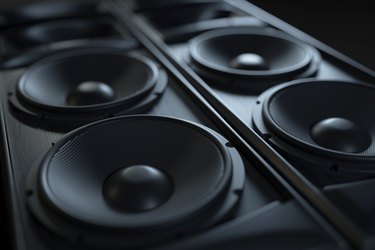
A high-quality surround sound system can enhance a home theater or living room listening experience, and installing new speakers in a car can turn long drives into rolling concert experiences. However, if your speakers begin to vibrate or shake, not with the bass-heavy subwoofer vibration you experience when listening to certain songs but with a dull rattling or static sound, the extra noise doesn't just interfere with audio playback; it can give you headaches or migraines. If your speakers are experiencing vibration problems, try troubleshooting them in a few ways.
Adjust Settings and Mounting
Video of the Day
The first thing to do when attempting to diagnose speaker vibration is to check the audio settings. While surround sound systems and other speakers are designed to produce audio at a louder level than the speakers of a computer, television, or similar device, speakers are still sensitive equipment. Speaker operation can be affected by strange or unbalanced audio configurations. Lowering the volume and adjusting the bass, balance, and fade settings may stop the vibration entirely. Also, check your speakers to ensure that they aren't dirty – dust and grit can cause a speaker to behave oddly – and that they're properly secured to their mounts and stands. Tighten any screws or panels that are loose and use plastic foam inserts to secure wall-mounted speakers if they're making uneven contact, which could be causing the rattle.
Video of the Day
Car Speaker Rattle Fix
If the speakers inside your car are vibrating, there may be a few causes. If the vibration occurs during regular operation of the car but not while the vehicle is stationary, it may be the result of less-than-ideal road conditions or an object in the car door compartments if the offending speakers are located there. If adjusting the audio settings and securing the speaker's mounting fails to solve the car speaker rattle, a fix may be found in the form of vibration dampener panels. By installing these specially shaped foam panels under the hood, in the trunk, and on the floor of your car, you may be able to stop any extra movements or shifting in the car that could be causing the speakers to rattle and vibrate. At the same time, they increase the sound quality in the car.
Replacing Blown Speakers
If all other troubleshooting tips fail to stop the sound system or car speaker vibration noise, it's possible that the speakers may have blown, at which point they need to be replaced to stop the noise. To check for a speaker blowout, play a soft song like a classical arrangement through the speakers at a moderate volume and get close to the speaker itself. If you hear a popping noise or it sounds fuzzy or like the sound is coming through a static haze, it's worth inspecting that speaker further. Disconnect it from its power source, remove it from its mounting, and then gently pry off the front cover to reveal the bare speaker. A blown speaker often has a tear in its audio cone or produces a hollow rattle when shaken. If this is the case, remove and replace the speaker.